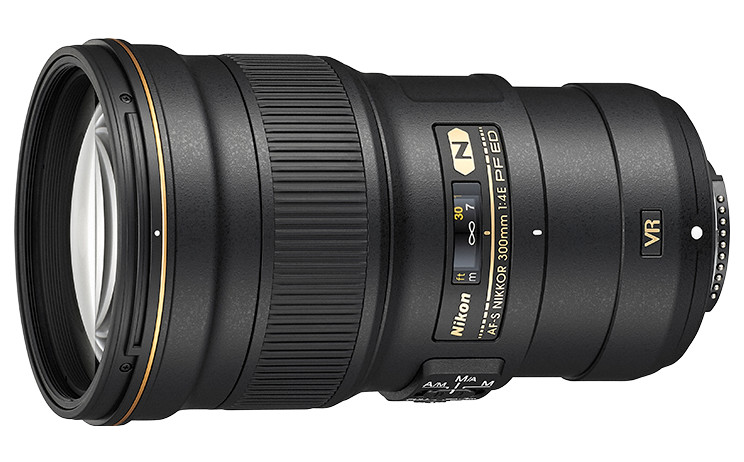AF-S NIKKOR 300mm f/4E PF ED VR
January 6, 2015
The world's lightest fixed focal length (prime) telephoto lens with a focal length of 300mm and maximum aperture of f/4, achieved with the adoption of a PF (Phase Fresnel) lens element, a first for NIKKOR lenses

TOKYO - Nikon Corporation is pleased to announce the release of the AF-S NIKKOR 300mm f/4E PF ED VR, a fixed focal length telephoto lens compatible with Nikon FX-format digital SLR cameras.
The AF-S NIKKOR 300mm f/4E PF ED VR is a fixed focal length telephoto lens with a focal length of 300mm*1 and a maximum aperture of f/4. As the first NIKKOR lens for which a PF (Phase Fresnel) lens element has been adopted, the AF-S NIKKOR 300mm f/4E PF ED VR not only weighs approximately 545 g less than the previous fixed focal length telephoto lens*2, but it is approximately 75 mm shorter in total length (from camera lens mount flange) and its maximum diameter is approximately 1 mm smaller. This significant decrease in size makes it the world's lightest*3 lens of its type. In addition, it offers a vibration reduction (VR) function that exhibits camera shake compensation equal to a 4.5-stop*4 increase in shutter speed. The lens is also equipped with a SPORT VR mode, which enables effective photography of athletes and other subjects that are moving rapidly and unpredictably. This makes the lens highly portable and easy to handle with hand-held shooting, despite the fact that it is a fixed focal length telephoto lens.
Adoption of Nano Crystal Coat lens coating enables crisp, clear images, and adoption of a PF lens element and an ED lens element achieves superior optical performance with little chromatic aberration. The AF-S NIKKOR 300mm f/4E PF ED VR enables expression of the beautiful blur characteristics possible only with a fixed focal length lens with a maximum aperture of f/4. This lens allows users to enjoy imaging expression that utilizes the characteristics of fixed focal length telephoto lenses with capture of a wide variety of photographic scenes, from sporting events and wildlife to landscapes and portraits.
Further, adoption of an electro-magnetic aperture mechanism makes for more stable auto exposure (AE) with high-speed continuous shooting. In addition, Nikon's exclusive and highly durable fluorine coat adopted for the surface of the front lens element effectively repels water and oils, and makes cleaning the lens easier even when it does get dirty.
- *1When used with a Nikon DX-format digital SLR camera, the effective angle of view is equivalent to that of a lens with a 450mm focal length in 35mm [135] format.
- *2The Ai AF-S Nikkor 300mm f/4D IF-ED
- *3Among 300mm fixed focal length (prime) AF lenses compatible with 35mm "full-size" format cameras available as of January 6, 2015. Statement based on Nikon research.
- *4Measured in accordance with CIPA standards in NORMAL mode using an FX-format digital SLR camera.
AF-S NIKKOR 300mm f/4E PF ED VR Primary Features
- A fixed focal length telephoto lens with a focal length of 300mm and a maximum aperture of f/4 compatible with Nikon FX-format digital SLR cameras
- The first NIKKOR lens for which a PF (Phase Fresnel) lens element has been adopted, making it the world's lightest*1 lens of its type
- Equipped with a SPORT VR mode for effective photography of athletes and other subjects that are moving rapidly and unpredictably in addition to a vibration reduction (VR; camera shake compensation equivalent to a 4.5-stop*2 increase in shutter speed) function
- Adoption of a PF (Phase Fresnel) lens element, an ED lens element, and Nano Crystal Coat for superior optical performance with which chromatic aberration and ghost are suppressed
- Capable of expression of the beautiful blur characteristics possible only with a maximum aperture of f/4
- Equipped with an electro-magnetic aperture mechanism that enables stable auto-exposure with high-speed continuous shooting
- Adoption of Nikon's exclusive and highly durable fluorine coat, which effectively repels water and oils, and makes cleaning the lens easier even when it does get dirty, on the surface of the front lens element
- *1Among 300mm fixed focal length (prime) AF lenses compatible with 35mm "full-size" format cameras available as of January 6, 2015. Statement based on Nikon research.
- *2Measured in accordance with CIPA standards in NORMAL mode using an FX-format digital SLR camera.
PF (Phase Fresnel) Lens Elements
The PF (Phase Fresnel) lens, developed by Nikon, effectively compensates chromatic aberration utilizing the photo diffraction phenomenon*. It provides superior chromatic aberration compensation performance when combined with a normal glass lens. Compared to many general camera lenses that employ an optical system using the photorefractive phenomenon, a remarkably compact and lightweight body can be attained with less number of lens elements.
- Diffraction phenomenon: Light has characteristics as a waveform. When a waveform faces an obstacle, it attempts to go around and behind it, and this characteristic is referred to as diffraction. Diffraction causes chromatic dispersion in the reverse order of refraction.
Notes
Due to the characteristics of a PF (Phase Fresnel) lens that utilizes the photo diffraction phenomenon, when there is a strong light source within the frame or when light enters the lens from outside of the frame, ring-shaped colored flare may occur according to shooting conditions. This phenomenon can be minimized with "PF Flare Control" included in Capture NX-D. See the comparison images below: original image (above), PF Flare Control applied (below). Refer to the software manual for more information. Capture NX-D is available from our website. Please download and use the latest version.
- *Specifications, design, product name and supplied accessories may differ by country or area. Specifications and equipment are subject to change without any notice or obligation on the part of the manufacture.
The information is current as of the date of publication. It is subject to change without notice.
